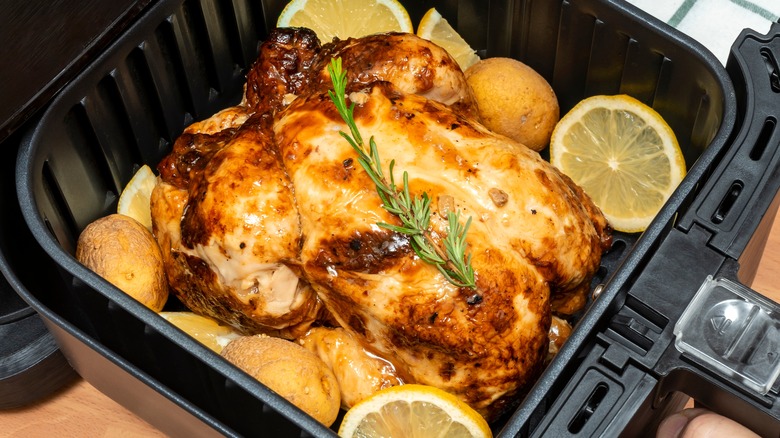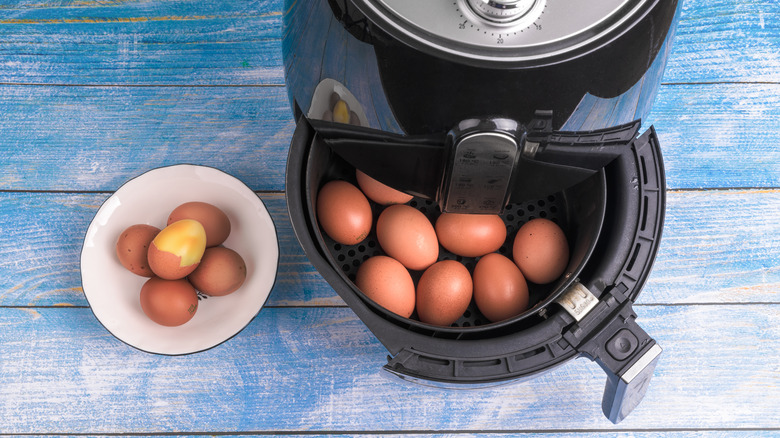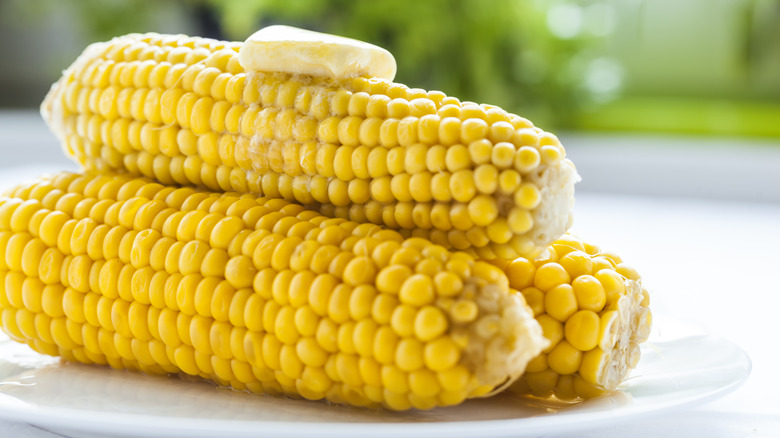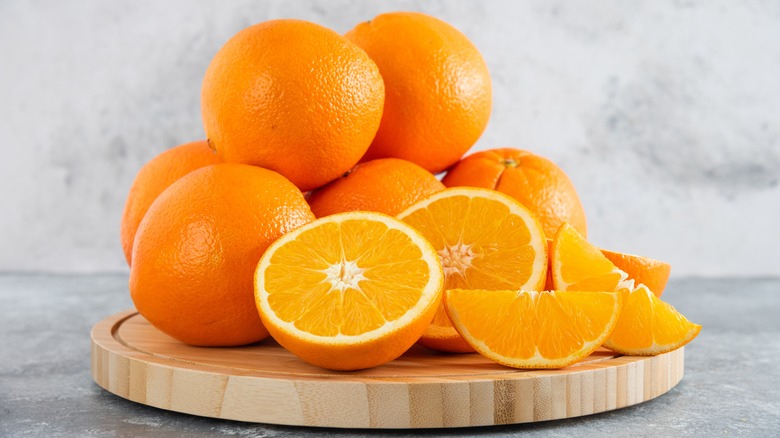14 Foods You Never Thought To Put In Your Air Fryer, But Should
If you haven't joined the air fryer revolution yet, you're missing out. The air fryer was introduced way back in the prehistoric year 2010 and had its first major sales boom in 2017. Since then, it feels as though they've never stopped being popular, and as more people every day take note of their advantages, they're only set to grow even more attractive and lucrative for manufacturers.
Air fryers are the perfect appliance for space- and energy-conscious consumers. Their small size, combined with their convection technology, makes them perfect for cooking smaller portions of food without having to turn on your entire oven. Their snugness also means that they can cook food way more quickly than when using other methods.
The real advantage of air fryers, though, is that they can cook anything — and we mean anything. You might have fallen into the habit of only using your appliance for certain foods, but if you have, you're missing out on a world of recipes that can be whizzed up in the air fryer in no time, simultaneously saving you space, time, and power. From potatoes to popcorn, onions to oranges, here are a few of our most out-there air fryer favorites.
1. Eggs
How do you like your eggs in the morning? Air-fried, you say? Now you're speaking our language. Eggs can be cooked in all manner of ways in the air fryer, with fried eggs, poached eggs, and even omelets mere minutes away when using your appliance. One of the benefits of using your air fryer to cook eggs is the removal of numerous utensils and pans from the process. Air-frying eggs, in all their various recipes, can also be a great way to cut down on oil and stop your recipes from becoming greasy.
Arguably our favorite, however, is "hard-boiling" eggs in the air fryer. To do this, you don't need any water at all: You simply need to put your eggs in the air fryer preheated to roughly 275 degrees Fahrenheit and allow them to cook for 15 minutes. If you want a softer-boiled egg, reduce your cooking time by a few minutes, with 10 minutes being optimum for a runny yolk. This method is a great way to batch-cook multiple eggs in one go ahead of time and doesn't require you to stand over a boiling pot of water first thing in the morning.
2. Steak
Endless amounts of time have been spent in the pursuit of cooking the perfect steak, and there's a dizzying amount of advice out there on optimum times, temperatures, pans, and preparations. So it might be slightly surprising to hear that you can, somewhat incredibly, air-fry a steak and have it turn out pretty well. Air-frying a steak gives you an even cook all over your meat, as the wrap-around heat of your appliance warms the steak from every side. Containing your steak within the air fryer also helps you avoid any meat or fat splatters, which can get everywhere if you're frying on the stove.
A medium-rare steak takes a couple of minutes on each side in the air fryer at a 400-degree-Fahrenheit temperature. Although the hot air will circulate around the beef, flipping it halfway through will maximize its evenness. One thing you can't quite achieve easily in an air fryer, though, is a deep-brown, crusty exterior with a rare inside — but we've got a solution for that. Simply cook your steak in the air fryer and pull it out a minute or two early before throwing it onto a hot (and we mean hot) pan or grill. This will give your meat a good sear, developing its color and flavor. Make sure to only do this briefly, though, so you don't overcook the steak.
3. Corn on the cob
For a relatively small food, cooking corn on the cob can take a lot of equipment. While grilled corn on the cob is delicious, it means firing up your entire barbecue, and cooking it on the stove requires a large pan and a lot of heat. Luckily, your air fryer comes to the rescue here. With your air fryer, corn on the cob takes little more than some oil and a little time. The circulating heat is particularly effective on the outer kernels of corn, browning them and making them simultaneously crispy and chewy. Placing them in a basket and letting them cook also gets rid of the fiddliness of trying to develop color all over the round cob, which can take near-constant movement if cooking them on a stove or grill.
Both fresh and frozen corn on the cob can be cooked in the air fryer, both with great results. Frozen cobs should be cooked at 400 degrees Fahrenheit for 10 to 12 minutes, and you should make sure to preheat your basket first. Fresh corn takes a similar amount of time but at a slightly lower temperature. It's important to flip your corn halfway through the cooking process, as it'll brown at a different rate on each side.
4. Grilled cheese
One of the biggest challenges when it comes to grilled cheese is trying to get the cheese to melt properly. Too often, you'll find that one side of the sandwich has ended up warmer than the other, leaving half the cheese soft and the other half solid. You can prevent this from happening, though, and save yourself time and endless flipping by using an air fryer. When placed in an air fryer and brushed with a little butter, cheese sandwiches become virtually indistinguishable from a pan-fried grilled cheese, developing a crispy exterior and a melted, soft interior.
Air-frying is a fantastic way to produce several grilled cheese sandwiches in one go, and because the convection browns the bread gently, you don't have to worry about it scorching as much. An air fryer grilled cheese will generally take about four minutes on each side in an appliance set to 370 degrees Fahrenheit. When assembling your grilled cheese, try to make sure that no cheese is hanging off the edge so that it doesn't drip down and out of the basket. It can also be a great move to cook your sandwich at a slightly lower temperature for a few minutes before cranking the air fryer up, to ensure that your cheese warms through and melts fully.
5. Potatoes
If you've ever despaired at having to heat your whole oven to cook one baked potato, this next one's for you. Air fryers are the perfect appliance for baking one or two potatoes at a time, given that they're essentially mini-ovens that sit on your countertop. An air fryer baked potato will develop the crisp skin and pillowy interior that oven baking will produce and can be cooked in pretty much the same way. Simply prick your potato, coat it in a little oil, and put it in a 400-degree-Fahrenheit air fryer.
It's worth pointing out that air-frying baked potatoes doesn't cut down their cooking time too significantly. At 400 degrees, they'll still take roughly 40 minutes to cook (although this can be a little shorter than using your oven). What they do cut down on, though, is energy use. Running a 1,500-watt air fryer for an hour requires significantly less energy than running a 2,200-watt electric oven for the same amount of time, and therefore you'll spend less money when preparing your meal. If you're really in a rush, though, you might want to throw your potato in the microwave.
6. Bread
When you think of cooking bread, your mind probably goes immediately to your toaster — but that's not the only appliance you can use. You can rustle up many bread-incorporating recipes in your air fryer, from French toast to homemade bread made directly in your fryer basket. One of our favorite ways to cook bread in an air fryer, though, is simple: using it to make croutons. These hard, crispy nuggets of bread are usually toasted, but making them in an air fryer allows you to cut down on the amount of oil used.
Homemade air fryer croutons are also usually easier to eat than store-bought croutons, which can be needlessly dehydrated and therefore overly crunchy. They'll also last an impressive amount of time, staying fresh for up to three months after cooking when sealed in an airtight bag. When making croutons, make sure to put your bread pieces in an even layer in your fryer basket so that each piece has easy access to the same amount of heat and circulating air, which can help to whip moisture away from them and crisp them up.
7. Popcorn
If you don't have a popcorn machine at home, you usually have two choices to get your movie snack fix: Make a bag of ultra-greasy, super-salty microwave popcorn, or risk life and limb by cooking it on the stove and having the searing kernels fly everywhere. Luckily, though, your air fryer can do just as good of a job. It only takes a few minutes at 400 degrees Fahrenheit for a batch of popcorn to be ready in your air fryer, and you can use pretty much any fat or seasonings you like. You can even skip the fat entirely if you want ultra-light popcorn — it'll still turn out great.
When making popcorn in your air fryer, lining your fry basket is key. Because popcorn kernels are so small, they tend to fall through the slats in the air fryer's interior. Fully lining it with aluminum foil or parchment paper helps to prevent this and also retains heat. You should also avoid putting too many kernels in, as this can prevent them from cooking evenly and may cause an overflow or clog in your appliance. If you're a fan of buttery popcorn, it's best to add the butter at the end, as the temperature of the air fryer can cause the fat to smoke and burn.
8. Apples
If you've never done it before, drying your own fruit can seem pretty daunting. With your air fryer, though, it can be a doddle. If you're lucky enough to have an air fryer with a dehydrate function, you can throw in any fruit you like, fire up your machine, and watch your produce transform.
Air fryers without dehydrate functions are still more than capable of drying (and somewhat cooking) fruit, and apple chips are one of our favorite things to use them for. You merely have to throw thin apple slices into the frying basket, add any spices you wish to flavor them, and cook them at 300 degrees Fahrenheit for about seven minutes. Because air fryers produce heat via hot, circulating air, the convection action works to dry the apples out, turning them crispy. If you find that your apple chips are still a bit moist after their first cycle, try running them through another cycle or adjust your recipe the next time you make them, experimenting with a lower temperature and a longer cooking time or slicing them more thinly.
9. A whole chicken
Air fryers come in all shapes and sizes, and if you're lucky enough to have a large one, you may have more options than you think. One of these options is to throw your Sunday chicken in your air fryer, allowing you to skip the use of your oven entirely. As air fryers are essentially small stovetop fan ovens, they provide the same circulation of heat that crisps chicken skin so well, while keeping the meat juicy and tender.
To make an air fryer roast chicken, however, you need to make a few key adjustments. The first is to begin with your chicken breast-side down in the basket, so that the fat in the meat on the underside of the chicken can lubricate the white meat as it cooks, stopping it from going dry. You should also flip your chicken about two thirds of the way through your cooking process (most chickens will take about 90 minutes to cook fully) so that the skin on top can crisp at the end. Make sure you oil your frying basket so that the skin doesn't stick. Above all, though, you should ensure you have the right size chicken to start with. If in doubt, go a little smaller, as the last thing you want is for it not to fit in the basket.
10. Onions
There's barely a recipe out there that doesn't use onions, but we believe that this essential ingredient should be allowed to shine on its own a little more often. One of the ways to let it do so is with your air fryer. There are multiple ways to cook onions with your air fryer, and you can make caramelized or crispy onions easily in the appliance. You can also make delectable balsamic onions, which you can then stud into a tart or add to a salad.
If you're like us, though, you'll want to be a bit more ambitious than that — and a whole blooming onion made right in your air fryer is the way to go. After you cut your onion into the bloom shape, you then bread it in an egg and spiced flour coating like normal. However, while at this point, chefs would normally take their onion creation over to the deep fryer, instead you should spray it with cooking oil and put it in your frying basket. After cooking it at 300 degrees Fahrenheit for 20 minutes, the blooming onion will look identical to its deep-fried siblings and be just as tasty, without covering your kitchen (and fingers) in grease.
11. Ravioli
Pasta and air fryers don't usually go together, but ravioli is an exception. The quintessential stuffed pasta can be turned into a moreish pre-dinner snack with the help of your frying basket, turning from fresh to toasted ravioli in about five minutes, or 10 minutes if you're using a frozen version. Toasting ravioli in an air fryer allows you to dispense with the thick batter that deep-fried ravioli usually comes coated in, as well as the large amounts of oil it takes to cook it. You just have to toss your pasta pieces in a little olive oil, fire up your machine, and wait. Your ravioli will come out crispy and browned while remaining soft on the inside.
You're not just limited to ravioli here, though. Other stuffed pasta can be rustled up near-instantly in this holy appliance. Like ravioli, tortellini turns lightly crispy in the air fryer, and you can coat it in parmesan to make it even crunchier. Manicotti, meanwhile, can be cooked from scratch in a marinara sauce, with the tomato helping to soften the pasta. Other types, like cappelletti, tortelli, and mezzelune, can also achieve the same crispy effect that ravioli does.
12. Garlic
Roasted garlic can add depth to any dish, with the normally sharp vegetable turning sweet, nutty, and mellow. However, firing up your entire oven to make a few bulbs of roasted garlic can be a serious waste of energy and space, especially when you have an air fryer. Quick roasted garlic can be rustled up in half the time it normally takes to cook it in the oven, thanks to your air fryer's more contained space encouraging speedy roasting, with a full bulb taking just 20 minutes to brown and soften. Once cooked, it will have all of the flavor that a slower-roasted bulb will have.
Going even lower and slower with your garlic cloves can produce even more luxurious results. You can make sweet-savory garlic confit by submerging garlic cloves in olive oil plus any desired herbs, placing them in a heatproof container, and roasting them at 275 degrees Fahrenheit for an hour. Like roasted garlic, using the air fryer for this recipe can halve the time it takes when cooking it on the stovetop or in the oven. Just remember not to pull your garlic pieces out immediately, though — when it's finished cooking, both your container and your oil will be scorching hot.
13. Rice
Rice in an air fryer? It sounds pretty out there, but somewhat incredibly, it can be done! You can cook up simple long-grain rice without the use of a rice cooker by placing it in a cake tin with some boiling water, covering it with aluminum foil, and then throwing it in a roughly 400-degree-Fahrenheit air fryer for 25 minutes. Your rice will come out fluffy, steaming, and ready to go.
It's worth pointing out that this method is less suited to short-grain rice varieties, which benefit from steam action to help them cook effectively. You can, however, use your short-grain rice in other ways, namely by making air fryer fried rice. You simply place all of your pre-cooked fried rice ingredients and seasonings into a heatproof dish and run the whole mixture through an air fryer for around 15 minutes, stirring it every five minutes or so.
This is, of course, by no means a traditional fried rice recipe, but it's a great way to rustle it up if your stove is out of action. You can even cook the eggs beforehand in your air fryer by mixing up your eggs and desired spices, popping them in a heatproof bowl, and cooking at 350 degrees Fahrenheit for six minutes, beating halfway through.
14. Oranges
Of all the unexpected things you can throw in an air fryer, orange slices might be the weirdest. Doing so, however, can leave you with a delicious breakfast that takes mere minutes and provides a boost of early-morning nutrition. When you heat orange slices in your air fryer, the fruit softens and caramelizes slightly, developing its natural sugars and bringing out its citrusy notes. Once you pull the slices out, you can top them with whatever you want to make them a more substantial breakfast — granola, yogurt, and crumbled cheese are all great choices.
When air-frying oranges, it's important to remove the peel and pith entirely. Leaving it on may heighten the scent of orange wafting through your home, but it also may leave you chewing through bitter pieces of food. It's also a good idea to try to balance out the tartness of the orange with some sweetening ingredients, which will also help it caramelize. Honey, maple syrup, or a sprinkling of brown sugar can work wonders here. For those who prefer mellower notes of sweetness, a drizzle of molasses can help to temper the orange's brightness.














